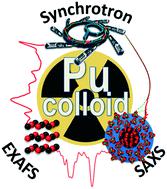当前位置:
X-MOL 学术
›
Environ. Sci.: Nano
›
论文详情
Our official English website, www.x-mol.net, welcomes your feedback! (Note: you will need to create a separate account there.)
Relevance of formation conditions to the size, morphology and local structure of intrinsic plutonium colloids
Environmental Science: Nano ( IF 7.3 ) Pub Date : 2020-06-29 , DOI: 10.1039/d0en00457j Cyril Micheau 1, 2, 3, 4, 5 , Matthieu Virot 1, 2, 3, 4, 5 , Sandrine Dourdain 1, 2, 3, 4, 5 , Thomas Dumas 3, 6, 7, 8, 9 , Denis Menut 10, 11, 12, 13, 14 , Pier Lorenzo Solari 10, 11, 12, 13, 14 , Laurent Venault 3, 6, 7, 8, 9 , Olivier Diat 1, 2, 3, 4, 5 , Philippe Moisy 3, 6, 7, 8, 9 , Sergey I. Nikitenko 1, 2, 3, 4, 5
Environmental Science: Nano ( IF 7.3 ) Pub Date : 2020-06-29 , DOI: 10.1039/d0en00457j Cyril Micheau 1, 2, 3, 4, 5 , Matthieu Virot 1, 2, 3, 4, 5 , Sandrine Dourdain 1, 2, 3, 4, 5 , Thomas Dumas 3, 6, 7, 8, 9 , Denis Menut 10, 11, 12, 13, 14 , Pier Lorenzo Solari 10, 11, 12, 13, 14 , Laurent Venault 3, 6, 7, 8, 9 , Olivier Diat 1, 2, 3, 4, 5 , Philippe Moisy 3, 6, 7, 8, 9 , Sergey I. Nikitenko 1, 2, 3, 4, 5
Affiliation

|
Fundamental knowledge about plutonium intrinsic colloids is a key issue for the prediction of plutonium transport and release rates in the environment. Recent studies demonstrated that the particle size and surface properties of intrinsic Pu colloids are strongly influenced by the preparation method. In this work, a combination of synchrotron small angle X-ray scattering (SAXS) with X-ray absorption spectroscopy (XAS) is used to characterize two kinds of stable plutonium intrinsic colloids prepared by hydrolysis of Pu(IV) ionic species and sonolysis of PuO2 in pure water. Despite their similarities, the multi-scale structural properties of these colloidal suspensions are found to be strongly influenced by the synthesis route. The hydrolysis approach leads to spherical nanoparticles of ca. 2.0 nm, whereas sonolytic colloids show elongated structures measuring 5.7 nm of thickness and >30 nm long. This difference results from the synthesis mechanism and can be attributed to nanoparticle aggregation in the absence of capping-ions. The results obtained by both SAXS and XAS approaches converge in the description of Pu(IV) intrinsic colloids as core–shell nanoparticles made up of a PuO2 core covered with a disordered Pu–O shell characterized by a splitting of Pu–O and Pu–Pu distances and an associated strong increase of associated DWF parameters. The local distortions of both Pu–O and Pu–Pu coordination spheres observed by XAS seem to be correlated with the nanoparticle shrinking probed by SAXS rather from the contribution of higher Pu oxidation states. The stabilization of the hydrolytic colloidal particles is further suggested from SAXS simulation to result from interaction with counter-ions from the medium.
中文翻译:

形成条件与固有p胶体的大小,形态和局部结构的关系
关于p固有胶体的基本知识是预测环境中p迁移和释放速率的关键问题。最近的研究表明,本征Pu胶体的粒径和表面性质受制备方法的强烈影响。在这项工作中,将同步加速器小角度X射线散射(SAXS)与X射线吸收光谱(XAS)结合使用,以表征通过Pu(IV)离子物质的水解和Son的声分解制备的两种稳定的intrinsic固有胶体。 PuO 2在纯净水中。尽管它们有相似之处,但发现这些胶体悬浮液的多尺度结构性质受到合成路线的强烈影响。水解方法导致球形纳米粒子约。2.0纳米,而声胶体显示拉长的结构,厚度为5.7纳米,长度大于30纳米。这种差异是由合成机理引起的,并且可以归因于在不存在封端离子的情况下纳米粒子的聚集。通过SAXS和XAS方法获得的结果在描述Pu(IV)本征胶体(由PuO 2组成的核壳纳米粒子)时趋于一致核心覆盖着无序的Pu-O壳,其特征在于Pu-O和Pu-Pu距离的分裂以及相关DWF参数的强烈增加。XAS观察到的Pu-O和Pu-Pu配位球的局部畸变似乎与SAXS探测到的纳米粒子收缩有关,而不是由较高Pu氧化态的贡献引起的。SAXS模拟进一步提出了水解胶体颗粒的稳定性,这是由于与来自介质的抗衡离子相互作用而产生的。
更新日期:2020-08-14
中文翻译:

形成条件与固有p胶体的大小,形态和局部结构的关系
关于p固有胶体的基本知识是预测环境中p迁移和释放速率的关键问题。最近的研究表明,本征Pu胶体的粒径和表面性质受制备方法的强烈影响。在这项工作中,将同步加速器小角度X射线散射(SAXS)与X射线吸收光谱(XAS)结合使用,以表征通过Pu(IV)离子物质的水解和Son的声分解制备的两种稳定的intrinsic固有胶体。 PuO 2在纯净水中。尽管它们有相似之处,但发现这些胶体悬浮液的多尺度结构性质受到合成路线的强烈影响。水解方法导致球形纳米粒子约。2.0纳米,而声胶体显示拉长的结构,厚度为5.7纳米,长度大于30纳米。这种差异是由合成机理引起的,并且可以归因于在不存在封端离子的情况下纳米粒子的聚集。通过SAXS和XAS方法获得的结果在描述Pu(IV)本征胶体(由PuO 2组成的核壳纳米粒子)时趋于一致核心覆盖着无序的Pu-O壳,其特征在于Pu-O和Pu-Pu距离的分裂以及相关DWF参数的强烈增加。XAS观察到的Pu-O和Pu-Pu配位球的局部畸变似乎与SAXS探测到的纳米粒子收缩有关,而不是由较高Pu氧化态的贡献引起的。SAXS模拟进一步提出了水解胶体颗粒的稳定性,这是由于与来自介质的抗衡离子相互作用而产生的。



























 京公网安备 11010802027423号
京公网安备 11010802027423号